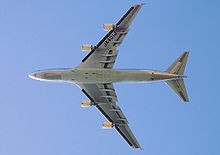Design
The 747-400's airframe features extended and lighter wings than previous 747s, capped by winglets. The winglets result in a 3 percent increase in long-range cruise, improved takeoff performance, and higher cruise altitudes.[14] The extended wingspan also gains an additional leading edge flap section.[14] When unfurnished, the basic 747-400 fuselage is lighter than preceding models, but when fitted out it is heavier and stronger than previous models.[23] The landing gear uses the same configuration as previous 747s, but with carbon brakes replacing the previous steel ones, and overall weight savings of 1,800 pounds (820 kg).[23]
The 747-400's glass cockpit features CRT displays which show flight instrumentation along with engine indication and crew alerting system (EICAS) diagnostics.[13] The flight engineer station on previous 747s is no longer installed, and the new displays and simplified layout results in a two-thirds reduction of switches, lights, and gauges versus the Classic 747.[13] Other new systems include an advanced Honeywell flight management computer (FMC) which assists pilots in calculating optimal altitudes and routes along with a Rockwell-Collins central maintenance computer (CMC) which automates troubleshooting tasks.[13]
The redesigned 747-400 interior features new cabin sidewalls, heat-resistant phenolic glass, carbon composite paneling, and larger storage bins.[15] An enhanced in-flight entertainment framework, called the Advanced Cabin Entertainment/Service System (ACESS), debuted on 747-400, which integrates 18-channel audio capability, four passenger intercom announcement zones, inter-cabin telephones, and passenger lighting into a central system.[24]An eight-bunk overhead crew rest is installed above the aft cabin, while a second crew rest area is located on the upper deck behind the cockpit for flight crew use.[24]
The last few 747-400s delivered features the Boeing Signature Interior, derived from the Boeing 777.[citation needed]












0 komentar:
Posting Komentar